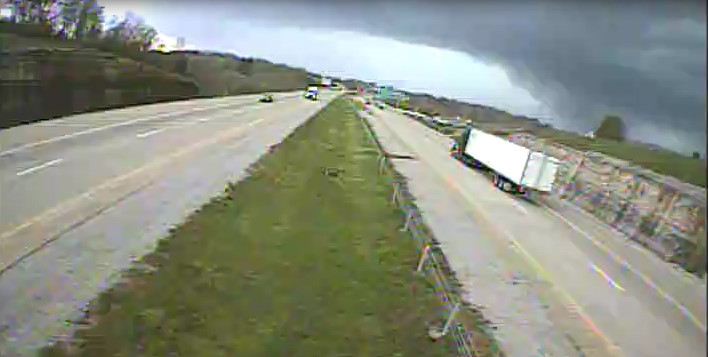April 2024
An INDOT traffic-count camera recently caught live footage of a tornado and survived being struck by the twister.
“Holding up during a tornado certainly increased our confidence in the equipment, which is why we have recently purchased four of the newer units and look forward to using them for years to come,” said Traffic Statistics Supervisor Greg Katter.
INDOT uses 80 Miovision Scout cameras throughout the state for the purpose of collecting lane traffic and turning-movement counts. The cameras are portable, and typically deployed for 24 hours. However, cameras deployed on interstates are in place for 48 hours and, occasionally, up to five days to get weekend traffic counts.
On April 2, a tornado roared through Jeffersonville in Clark County. A Miovision Scout camera, place at Mile Marker 11 on I-265 between 10th Street and International Drive, caught all the action.
To watch the video, which has no audio track, click here. (Approaching vehicles are headed eastbound toward Kentucky.)
The cameras capture volume and classification up to six class bins: motorcycles, passenger cars, light trucks, buses, single-unit trucks, and combination trucks,
They differ from the typical pneumatic tube counter in that they rely on post-process video image analysis to count and classify vehicles based on changes between frames of video and do not need to have equipment (hoses) in the roadway. Miovision cameras cannot gather speed data.
Video footage is typically not watched by humans, except when anomalies or failures are noted.
Instead of being reviewed by humans, the video is pulled from the cameras and uploaded to Miovision servers for processing. Data files are later downloaded, edited for format compliance, and uploaded to INDOT’s Traffic Count Database System.
In the case of the tornado, INDOT reviewed the video because Miovision reported that there was a failure during the study.
“But it turned out that the camera continued recording during and after a tornado, which is a testament to the durability of the equipment,” said Katter. “Even through the heavy rain obscuring the camera, it was still possible to get an idea of what was occurring.”
INDOT has been using these cameras since 2010, in part to keep INDOT workers and equipment off the roadway. Setting up pneumatic tubes across highways and interstates is dangerous.
This is the first known recording of a tornado in the 14 years that INDOT has deployed these cameras.

